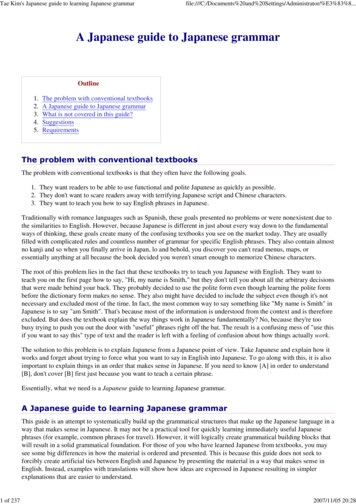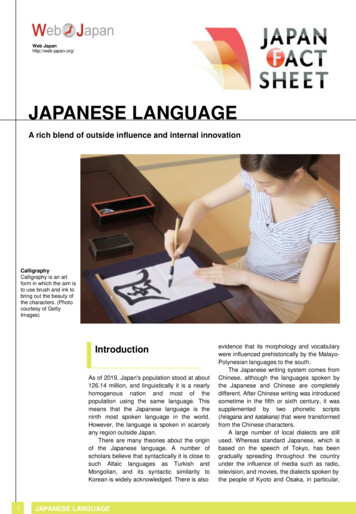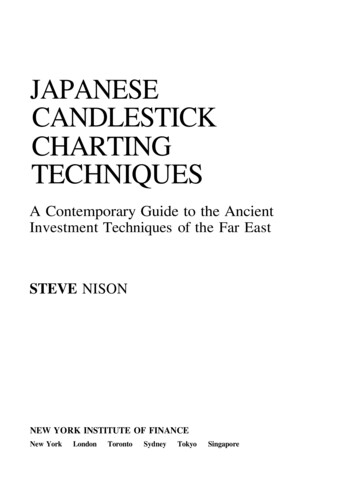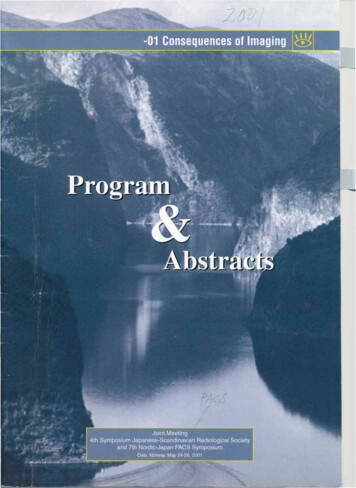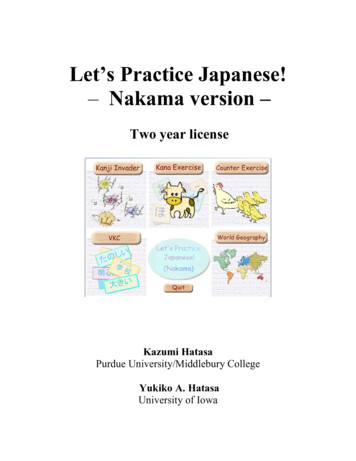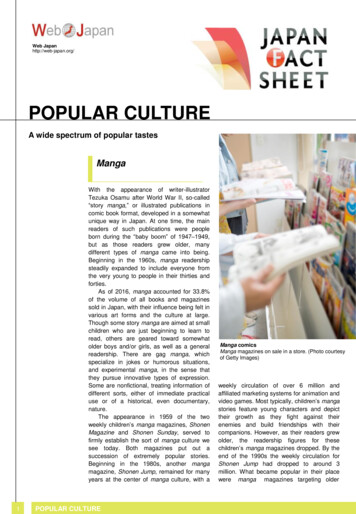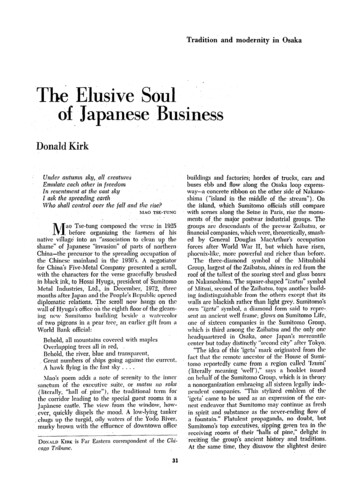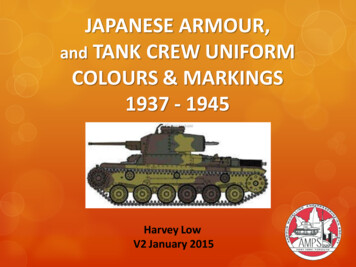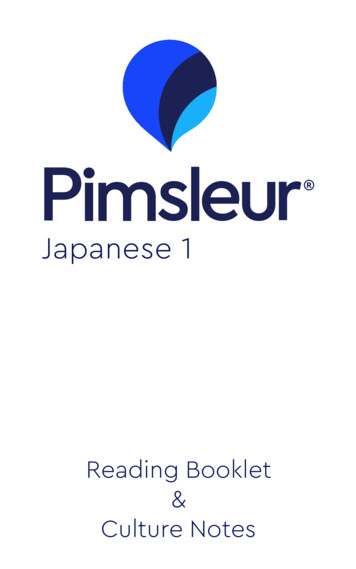
Transcription
Japanese 1Reading Booklet&Culture Notes
Japanese 1Travelers should always check withtheir nation's State Department forcurrent advisories on local conditionsbefore traveling abroad.Third EditionBooklet Design: Maia KennedyFalcon Font (optional characters): Hayato Kirikaze and ‰ Recorded Program 2002 Simon & Schuster, Inc. Reading Booklet 2015 Simon & Schuster, Inc.Pimsleur is an imprint of Simon & Schuster Audio,a division of Simon & Schuster, Inc. Mfg. in USA.All rights reserved.ii
Japanese 1ACKNOWLEDGMENTSVoicesEnglish-Speaking Instructor. Ray BrownJapanese-Speaking Instructor. Makoto TakenakaFemale Japanese Speaker. Kimiko Ise AbramoffMale Japanese Speaker. Tsunenori “Lee” AbeCourse WritersKimiko Ise Abramoff Beverly D. HeinleHiragana Readings WritersKimiko Ise Abramoff Liz HorberNotes AuthorDr. Akira MiyaharaEditorsMary E. Green Miho HirohashiProducer & DirectorSarah H. McInnisRecording EngineersPeter S. Turpin Kelly SauxSimon & Schuster Studios, Concord, MAiii
Japanese 1Table of ContentsIntroduction. 1Lesson One . 7Lesson Two . 8Lesson Three . 9Lesson Four . 10Lesson Five . 11Lesson Six . 12Lesson Seven . 13Lesson Eight . 14Lesson Nine . 15Lesson Ten . 16Lesson Eleven . 17Lesson Twelve . 18Lesson Thirteen . 19Lesson Fourteen . 20Lesson Fifteen . 21Lesson Sixteen . 22Lesson Seventeen . 23Lesson Eighteen . 24Lesson Nineteen . 25Lesson Twenty . 26iv
Japanese 1IntroductionThe Japanese language has three distinctivewriting systems: kanji, hiragana, and katakana.KanjiIn early Japan, Japanese was a spoken languageonly and there was no writing system. China,however, had already developed a sophisticatedwriting system based on symbols called hanzi. Asearly as the first century, Japanese people had someexposure to these Chinese symbols on coins, officialseals, and other decorative items imported fromChina. Like many other Asian countries, Japan adoptedthe Chinese writing system and by the 5th century,Chinese characters began to be used earnestly inJapan. The Japanese called this writing system kanji,which literally means “Chinese characters.”This new writing system created a new literacyfor the Japanese. When the Japanese adopted theChinese writing system, they used the characters torepresent both meaning as well as sound. As a result,in Japan there are two ways to “read” or pronouncea single Chinese character:· on yomi, based on the original Chinesepronunciation,· kun yomi, native Japanese pronunciation.
Japanese 1Many kanji have multiple pronunciations in bothon yomi and kun yomi.How many kanji are there?That depends on various sources. One of the mostcomprehensive dictionaries contains approximately85,000 characters, but only an estimated 7,000 aresaid to be in daily use. Today in Japan, a kanji dictionarycontains approximately 50,000 characters of which2,100 to 2,200 characters are commonly used.HiraganaSome Japanese sounds and meanings weredifficult to represent using kanji. To fill this gap,kana symbols were invented, based on the soundand the shape of the kanji. One such phoneticsystem is hiragana, which was invented betweenthe eighth and the tenth centuries. Unlike kanji,hiragana represent a sound and not meaning.Hiragana is derived from a cursive form of kanji andthe letters are curvilinear in style. They are used toexpress Japanese grammatical elements such asparticles and the endings of adjectives and verbs.There are forty-six basic hiragana syllables. Thereare also twenty-five additional modified syllables,thirty-six modified /contracted syllables, and onethat is used to transcribe double consonants.2
Japanese 1KatakanaKatakana came into existence at about the sametime as hiragana. The shapes of the katakana letterswere also formed based on the kanji, but katakanahave straighter lines, while hiragana are curvier.Today katakana is used mainly to write loanwords which the original Japanese language didnot have. An example is the word for “coffee,” sincecoffee didn’t exist in Japan until it was importedfrom abroad. Katakana is also used for representingonomatopeia, the names of plants and animals (withsome exceptions), and for placing emphasis oncertain words.There are the same number of katakana syllablesas hiragana.3
Japanese 1Reading KanaHiragana and katakana are phoneticallyconsistent, and reading them is relatively straightforward once the letters and their sounds are learned.Today in Japan, the three writing systems arecombined — kanji, hiragana, and katakana can allappear within a single sentence. Here’s an example:デパート に 行きます。(I) go to a department store. (depaato ni ikimasu.)デパートdepartment store (katakana)にpost positional word to show direction (hiragana)行the “root” of the verb “go” (kanji)きますending of the verb “go” (hiragana)In this course, you will learn how to readhiragana. For practice, all the words and sentencesin the Reading Lessons are written in hiragana.Spaces have been added in the longer phrases forease in reading.4
Japanese 1Basic Hiragana Chartaあka かiいkiき/き ku くsa さ/さ shi しtaたchi ちuうeえ oおke け ko こsu すse せ so そ/そtsu つte て to とne ね no のna な/な niにnu ぬha はhiひfu (hu) ふ/ふ he へ ho ほma まmi みya や/やraら/ら rimu む/むyu ゆyo より/り ru るre れ ro ろwa わnme め mo もoん5を
Japanese 1Hiragana with Diacritic �じぢびぴgu ぐzu ずzu づbu ぶ/ぶpu ぷ/ぷge げze ぜde でbe べpe ぺgo ごzo ぞ/ぞdo どbo ぼpo ぽHiragana with Small ゃ (ya), ゅ (yu), ょ (yo) , orModified / Contracted Syllableskya きゃ/きゃsha しゃcha ちゃnya にゃhya ひゃmya みゃrya りゃ/りゃgya ぎゃ/ぎゃja じゃja ぢゃbya びゃpya ぴゃkyu きゅ/きゅshu しゅchu ちゅnyu にゅhyu ひゅmyu みゅryu りゅ/りゅgyu ぎゅ/ぎゅju じゅju ぢゅbyu びゅpyu ぴゅkyo きょ/きょsho しょcho ちょnyo にょhyo ひょmyo みょryo りょ/りょgyo ぎょ/ぎょjo じょjo ぢょbyo びょpyo ぴょSmall letter tsu (っ) — transcribes double consonants6
Japanese 1Lesson �んこえほんえん7
Japanese 1Lesson �8
Japanese 1Lesson 19.20.ごはんかります。ががにほんご がにほんご が わかります。がんこりす が ��こしえいがわかい9
Japanese 1Lesson 9.20.のりますいい �わたしわたし はにほんじんわたし は にほんじんでですわたし は にほんじん です。ててほんこわすなにかそ or そそしてそなた10
Japanese 1Lesson う。ささん or さんたなかさん / たなかさんたなかさん に あいます。ざございますありがとう �、に、さん、し、ごぢはなぢ11
Japanese 1Lesson .20.おおてんき or きおてんきいい おてんき �す。ろごろところわたし の � に すんでいますか。ここ に すんでいます。どこ で のみますか。12
Japanese 1Lesson 19.20.くろいきおんぞどうぞどうぞ ��んへへたへんじべたべます。13
Japanese 1Lesson 19.20.ろく、しち、はちをほん を かいます。にほんご を はなします。れだれきれいねいい ですね。おねがいします。らあちら or あちらたべられません。さかな が たべられません。もあなたもどうも すみません。ついつもしつれい しました。14
Japanese 1Lesson 9.20.いくつもりです。や or �すきです。ふ or ふふゆふゆ に ゆき が ふります。めあめなつ に あめ が � いけます。でんわ を かけたいです。15
Japanese 1Lesson .20.ぬいめわれめねこ と いぬねほりはほりあおいむ or �づきこ / �ぜひ いきたいです。だください。16
Japanese 1Lesson ��さむい ��あの17
Japanese 1Lesson .19.20.ゆうびんぜんぶ で いくら ですか。ぼんさい を かいました。かんぱい を します。ぴあの が あります。ぷ or ぷふな / ぶなてんぷらてんぷら を �ぽぽさんぽ します。き/ やきゃきゃくおきゃくさま18
Japanese 1Lesson 18.19.20.てんぷら を おねがいします。ぴんぽん を します。ぺんぎん を �かいしゅぎ19
Japanese 1Lesson �ょく に いきます。せんしゅう、しゃしん を とりました。しょくじ を しましょう。ちゃおちゃおちゃ を あにゅにゅうこくめにゅう20
Japanese 1Lesson 8.19.20.おもちゃ の くるまちゅうごくご の べんきょうまつもとせいちょう の ほんめにゅう を どうぞ。こんにゃく が みゃくみゃくらく21
Japanese 1Lesson �ょうき / ��くごりゅりゅうがくりょりょかん22
Japanese 1Lesson �ょみんぎょぎょうじゃじゃあじゃあ また。じゃあ また あした。23
Japanese 1Lesson �うまぴょはっぴょう24
Japanese 1Lesson 18.19.20.すみません。 えいご が �。にほんご が わかりますか。はい、すこし わかります。あなた は あめりかじん ですか。はい、わたし は あめりかじん です。すみすさん、もう かまくら を みましたか。かまくら? まだみていません。かまくら は どこですか。ここから あまり とおくありません。とても きれいな ところ ですよ。そうですか。 よこはま は みました 。でも かまくら は まだ みていません 。じゃあ、あした いっしょに .かまくら へ いきませんか 。いいですね。でも あした の あさは .しごと が あります。じゃあ、 いつ が いい ですか。あさって は?ええ、けっこう です。25
Japanese 1Lesson Twenty1.むかし むかし .2.ひとりの おとこがいました。3.おとこの しごとは .4.こっとうや でした。5.あるひ ちゃみせに いきました。6.そこに ねこが いました。7.ねこは とても うつくしい さらで .8.えさを たべていました。9.おとこは さらが ほしい .10.と おもいました。11.(the antique the antique dealer)「いくらですか。」13.おとこは たくさんの おかねを .14.はらいました。15.ごしゅじんは いいました。16.(the café owner)「じゃあ、ねこを17.(the antique 8.(the café owner) 「いいえ、ねこだけ19.「え、じつは さらだけ ほしかったんです。20.でも ねこに たくさん おかねを �。」26です。」く
Japanese 1Culture Notes
Japanese 1Travelers should always check withtheir nation's State Department forcurrent advisories on local conditionsbefore traveling abroad.Booklet Design: Maia KennedyThird Edition and ‰ Recorded Program 2002 Simon & Schuster, Inc. Culture Notes 2010 Simon & Schuster, Inc.Pimsleur is an imprint of Simon & Schuster Audio,a division of Simon & Schuster, Inc. Mfg. in USA.All rights reserved.ii
Japanese 1ACKNOWLEDGMENTSVoicesEnglish-Speaking Instructor . . . . . . . . . . . Ray BrownMale Japanese Speaker . . . . . . . . . . . Tsunenori AbeCourse WritersKimiko Ise Abramoff Beverly D. HeinleEditorsMiho Hirohashi Mary E. GreenNotes on Japanese Culture & CommunicationDr. Akira MiyaharaProfessor of Communication StudiesSeinan Gakuin UniversityProducer & DirectorSarah H. McInnisRecording EngineersPeter S. Turpin Kelly SauxSimon & Schuster Studios, Concord, MAiii
Japanese 1Table of ContentsNotes on Japanese Culture and Communication.1sumimasen. 2Word Order. 3Expressions of Modesty and Deference inJapanese Communication. 3 ne. 4Omission of Subjects. 5domo. 6Public Transportation. 6nanika. 7Particles. 7Cognates and “Borrowed English Loan Words”. 9Addressing People . 10Counting Things . 10Meals of a Day. 11Circumlocution. 12Levels of Politeness. 13chotto. 14 masen ka?. 14Yen: Japanese Currency. 15Good-bye. 16takusan, sukoshi. 16iv
Japanese 1Drinks. 17itte kimasu. 18 desu ga. 18kyo wo nani o shimasu ka?. 19shujin, goshujin / kanai, okusan. 20hajimemashite / dozo yoroshiku. 21hitori, futari, san nin. 22otoko no ko, onna no ko.
Pimsleur is an imprint of Simon & Schuster Audio, . Japanese people had some exposure to these Chinese symbols on coins, official seals, and other decorative items imported from China. Like many other Asian countries, Japan adopted the Chinese writing system and by the 5th century, Chinese characters began to be used earnestly in Japan. The Japanese called this writing system . kanji .
